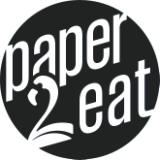
Did you know you could transform paper2eat Wafer Paper into flexible, fabric-like sheets? Our Wafer Paper isn’t just for printing, lighting on fire, or simple decorations—it can be transformed into a flexible, shimmering, edible fabric for any cake design. Whether you’re a professional cake decorator or a hobbyist looking to experiment, this method is very likely to be a game-changer for you.
For this tutorial we have Denise (@denises_delights_), demonstrating how to turn our 0.60 mm Wafer Paper Premium into stunning edible fabric that moves and shimmers like real textile. Whether you're looking to create delicate ruffles, elegant draping, or even edible bows, this step-by-step guide will show you exactly how it’s done.
Materials You’ll Need:
-
0.60 mm Wafer Paper Premium (a sturdy, flexible choice)
-
Food-Grade Glycerin (for pliability)
-
High-Proof Spirit (Clear Alcohol or Vodka) (helps evenly distribute moisture)
-
Soft Paint Brushes (for applying liquid and dusting shimmer)
-
Luster Dust or Food Coloring (for a gorgeous, fabric-like sheen)
-
Non-Stick Mat or Parchment Paper (for drying)
Step 1: Prepare Your Conditioning Solution
The secret to turning our Wafer Paper into a more flexible sheet is a carefully balanced conditioning mix. Combine equal parts glycerin and high-proof alcohol in a small bowl. Stir gently until fully blended. The alcohol will evaporate, leaving behind the glycerin to soften our Wafer Paper without making it too sticky.
Step 2: Apply the Mixture
Lay your 0.60 mm Wafer Paper Premium sheet on a clean, dry surface. Using a soft paintbrush, lightly brush the conditioning solution over one side of the Wafer Paper, making sure to coat the entire surface evenly. Avoid oversaturating—too much liquid can cause tearing or curling. Brush even paint strokes horizontally and then vertically. Flip the sheet over and repeat on the other side. The Wafer Paper should begin to feel slightly tacky but not wet.
Step 3: Add a Fabric-Like Sheen with Luster Dust or Food Coloring
For a luxurious, satin-like effect, use adry, fluffy brush to dust luster dust or food coloring over the surface of your Wafer Paper fabric. Apply multiple layers of your luster dust or food coloring in circular motions for an ultra-smooth, realistic look. Choose gold, pearl, or even iridescent shades to create a shimmering effect that mimics silk or satin
Step 4: Let It Dry Overnight
Place the Wafer Paper sheet on a non-stick mat or parchment paper and let it dry overnight so it can get to its right consistency. You’ll know it’s ready when it becomes flexible but still holds its shape. If it feels too dry, lightly brush on more of the solution. If it’s too wet, allow extra drying time.
Step 5: Shape and Use Your Edible Fabric
Now that your Wafer Paper has transformed into a flexible, edible fabric, it's time to shape it! Here are a few ways you can use it:
-
Drape it over cakes for a flowing fabric look.
-
Cut and fold it into edible bows for a couture-inspired cake.
-
Create ruffles by pleating or layering the sheets.
Pro Tips for Success
-
Work in a Humidity-Controlled Space – Too much moisture in the air can cause your edible fabric to become sticky or curl.
-
Test Your Glycerin Ratio – If your Wafer Paper is too stiff, add a touch more glycerin to your solution. If it's too soft, reduce the glycerin slightly.
-
Use a Light Touch with Luster Dust – Too much at once can clump; instead, build up layers gradually.
